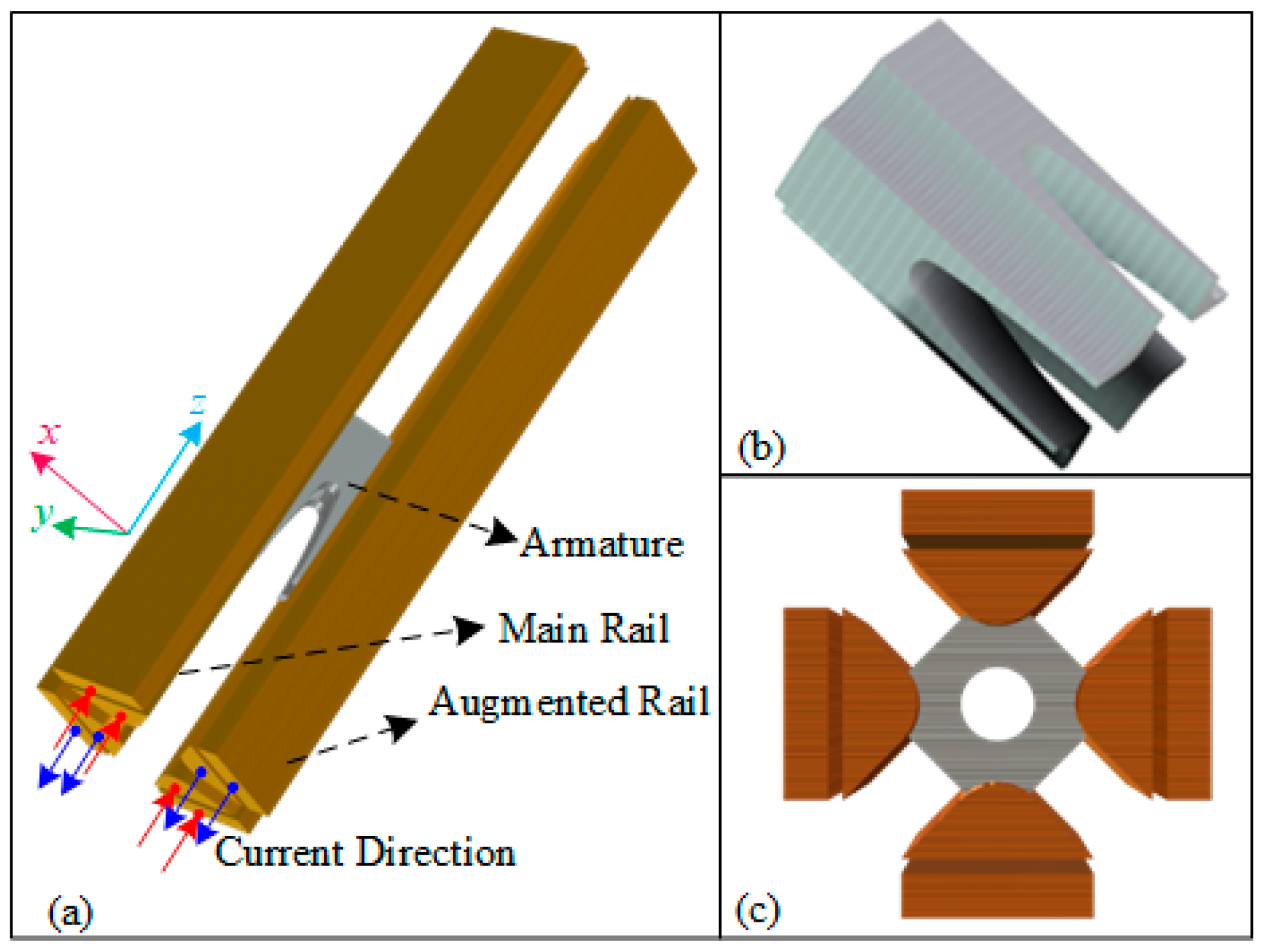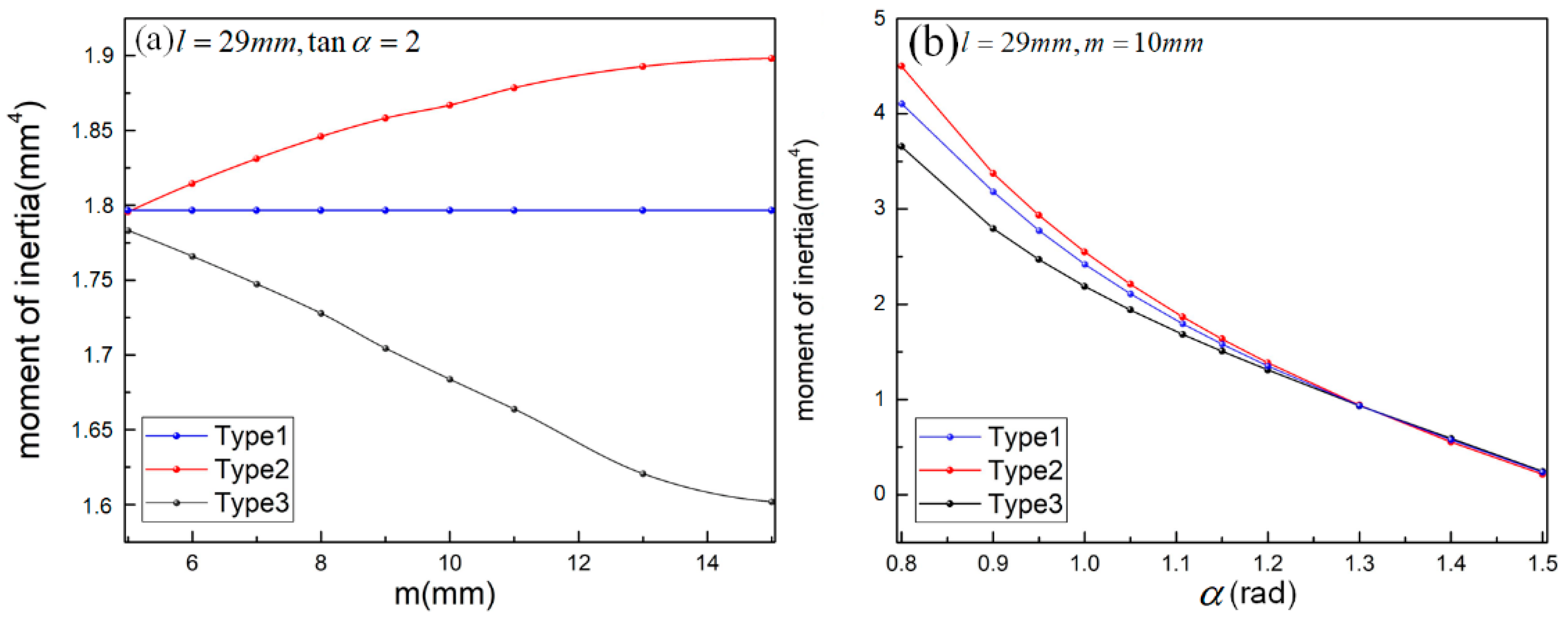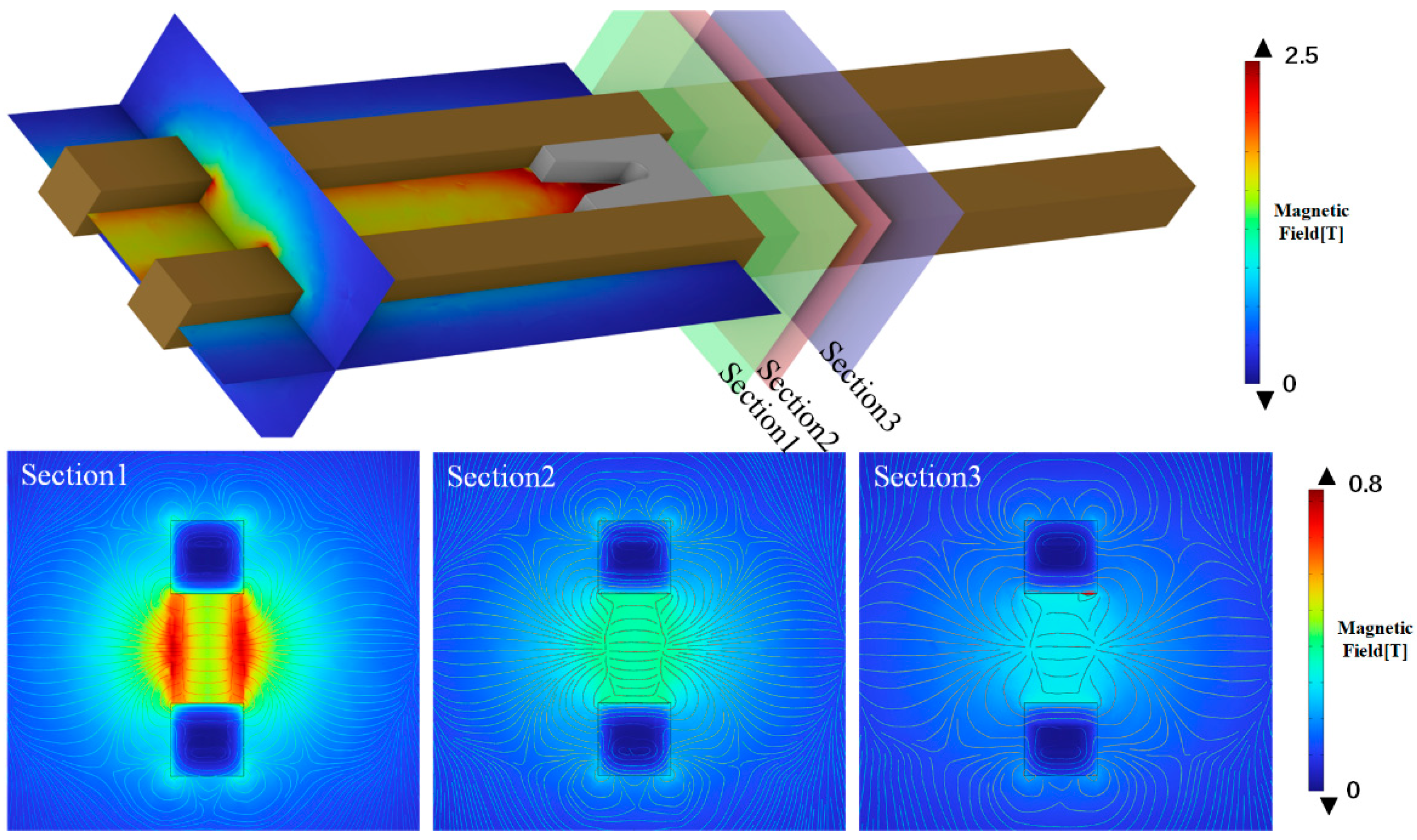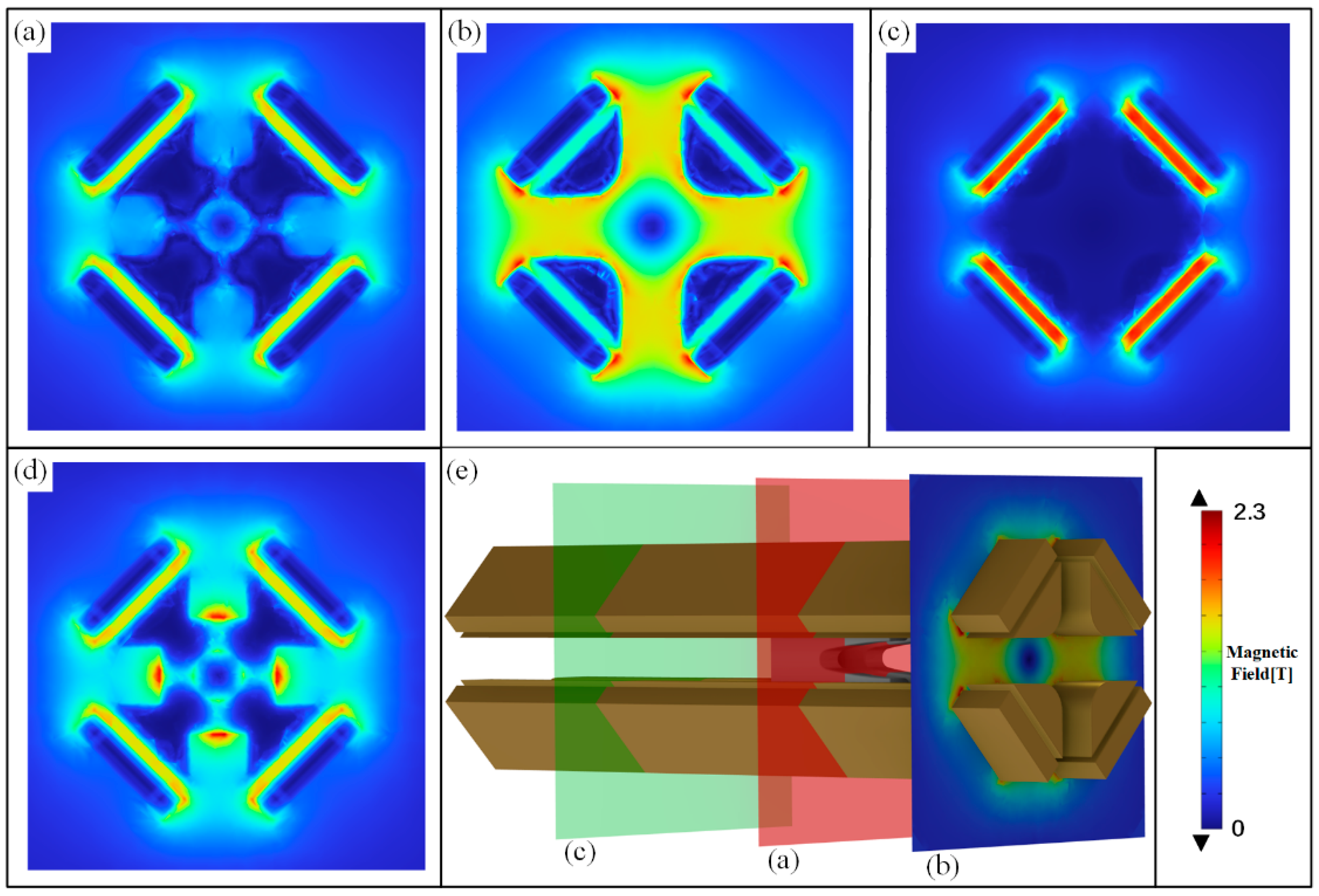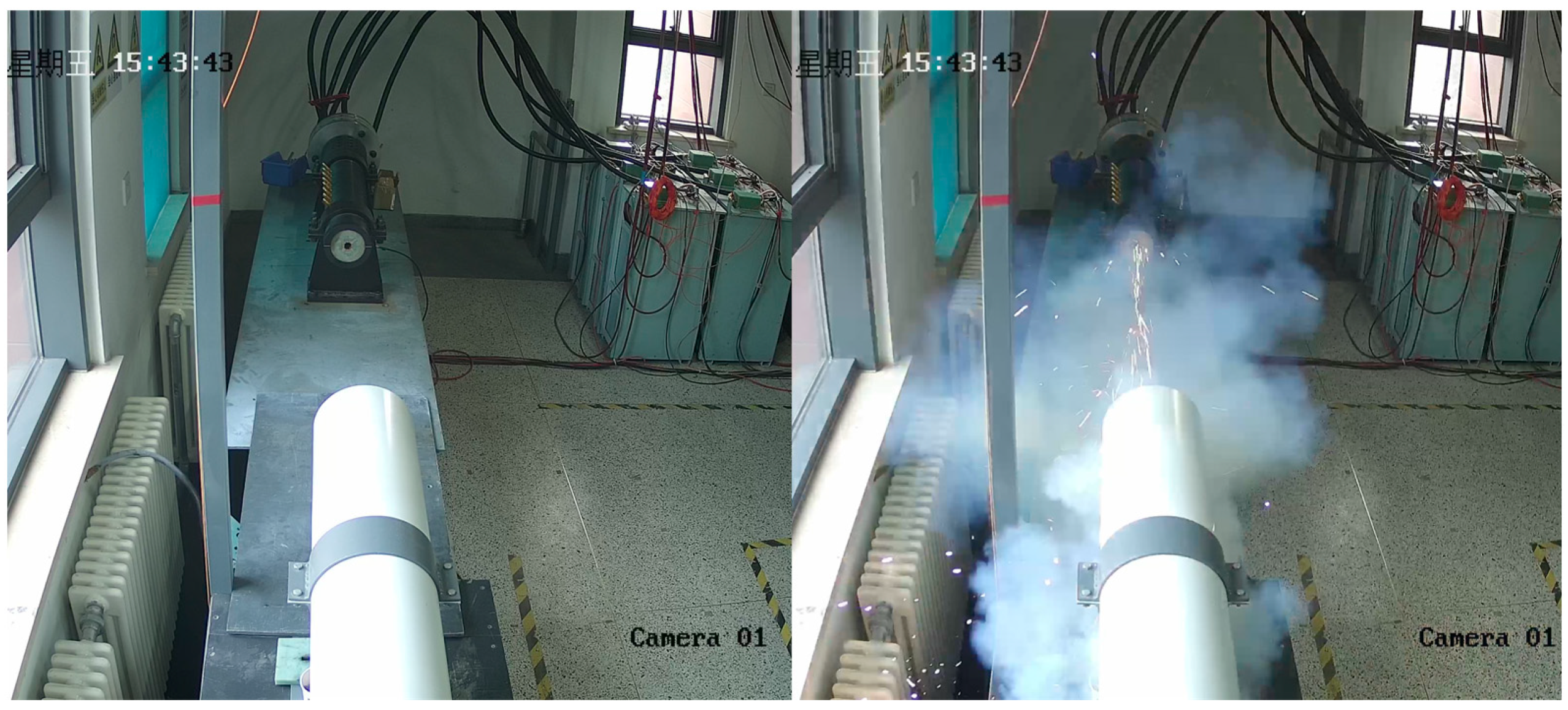1. Introduction
The electromagnetic railgun is a device that can efficiently convert high-power electrical energy into kinetic energy in an instant [
1,
2,
3]. Compared with the gunpowder launch method, the electromagnetic rail launch method has the advantages of high kinetic energy, high exit velocity, stable operation, good repeatability, precisely adjustable thrust, and short launch interval, according to Zhang B, Zeng D and Yu K [
4,
5,
6,
7], which is considered as the future direction of launch technology development in the military field. However, many problems have been encountered in the engineering process of railguns, mainly in (1) huge contact forces, great temperature changes causing armature and rail deformation, leading to contact failure [
8,
9,
10]; (2) strong magnetic field during the operation of the railgun, leading to the poor electromagnetic compatibility of the equipment [
11,
12,
13,
14].
At present, researchers mainly improve the contact characteristics of railguns by enhancing the properties of rail materials. Xie H et al. reviewed the development of materials used for railguns in recent years; Lin Q. H et al. studied the damage caused by railgun operation and analyzed the plastic deformation and fatigue fracture of the rail through simulation [
15]; Yao J studied the melting process of the rail and analyzed the effect of current and speed on the effect of the phase change of the rail [
16]; Davidson G et al. improved traditional rail made of copper material to enhance the hardness of the rail [
17]; Chen Y analyzed the sliding contact characteristics between the aluminum alloy armature and the rail of different materials [
18]; Wen Y, Keshtkar et al. studied the effect of material properties on the electrical characteristics of the railgun [
19,
20]. The above studies have effectively improved the performance of railguns, but so far, they have not been able to completely solve the two main problems encountered in the engineering of railguns. In addition to enhancing material performance and improving the anti-electromagnetic interference capability of the equipment [
21,
22], improving the armature–rail contact effectiveness of the electromagnetic railgun and improving the bore magnetic field environment of the railgun through reasonable structural design is also an important direction for the development of the railgun [
23,
24,
25,
26].
Many scholars have made rich conclusions about the structural design of electromagnetic railguns. Kim B and Hai-yu Miao et al. studied the effect of different parameters of armature and rail overfill assembly on the initial contact characteristics of the railguns [
25,
27]; Teng-da Li and Hsieh et al. compared the effect of concave, convex and flat rails on the current distribution of railguns [
24,
28] and qualitatively analyzed its effect on the railgun performance; Shuai Li [
29] et al. studied the effect of railgun caliber on the railgun performance Aigner S [
9], Dalvi S [
30], Chen J [
31], Heydari [
32], and Liu Y [
33] proposed new structures such as a partially augmented railgun structure [
34], spin armature railgun structure [
32,
35], quadrupole railgun structure [
36], and composite orbit railgun structure [
28], respectively, and made a preliminary discussion on the performance of railguns. The current ideas on the structural design of railguns mainly focus on enhancing the parameter index of the railgun, such as maximum current density, maximum temperature rise, etc., without considering more about the requirements of the railgun in use. In this paper, the structure and design of the railgun are studied with the objectives of enhancing the rail life and improving the electromagnetic compatibility of the railgun [
37].
In this paper, the specific performance of the railgun is linked with the structure of the railgun, and a hyperbolic augmented quadrupole railgun is proposed from the perspective of improving the contact performance of the railgun, extending the life of the rail, and improving the magnetic field environment in the bore of the railgun. In this paper, the deformation resistance of the rail is measured by the moment of inertia, and several parameters are designed to measure the contact characteristics of the railgun, and the railgun of different structures are investigated by FEM-BEM coupling simulation. Finally, we designed a railgun launch platform to verify the performance of the proposed structure. The experimental results show that the proposed structure can reduce rail damage and mitigate armature ablation.
3. Structure of the Rails and Contact between Armature and Rail
During the operation of the railgun, the huge electromagnetic force and complex mechanical force lead to the violent vibration and deformation of the rails, and the high-speed sliding and large temperature rise cause the contact state between the armature and rail to change sharply, which eventually leads to the rail ablation and life reduction. In this paper, three kinds of rails (concave, convex and flat) and their fits with armature are studied to analyze the contact and the deformation of the rails under the condition of interference fit and to provide reference for the structural design of the railgun.
Figure 3 shows the cross-sectional structures of the three kinds of rails and the corresponding armatures.
Figure 3a shows the current excitation of the railguns, where the dashed line indicates that the current is loaded at the end of the gun and the solid line indicates that the current is loaded at the muzzle;
Figure 3b shows the dimensions of the railguns and the design of three types of rails: the bases of the three types of rails are identical, and the contact surface parts are circular arcs tangent to the sides of the rails (convex rails, denoted as Type 2) and their symmetric arcs (concave rails, denoted as Type 3) and straight lines (flat rails, Type 1).
For the three structures of rails, according to their force characteristics (electromagnetic force perpendicular to the axial direction), they can be considered as elastic beams. According to the differential equation of the deflection curve of the beam:
The ability of a rail to resist deformation can be measured by the moment of inertia of the rail section relative to its center of mass. For rails made of the same material, the larger the moment of inertia, the stronger their ability to resist deformation. The moment of inertia is a function of the shape of the rail section, and for any shape of rail, its moment of inertia relative to the origin of coordinates can be expressed as:
where
is the rail cross-section region. According to the parallel axis theorem, the moment of inertia of this rail cross-section with respect to its centroid can be expressed as:
where
is the cross-sectional area of the rail and
is the abscissa of the cross-sectional center of the rails.
The moments of inertia of each of the three rails are solved below based on the coordinate system shown in
Figure 4.
For Type 1, the shape center coordinates and area are, respectively:
Its moment of inertia relative to the origin of the coordinates is:
Its moment of inertia relative to the centroid is:
In order to solve for the moments of inertia of the Type 2 and Type 3 rails, it is necessary to calculate the area of region
A first. The area of region
A is obtained by integration as
. The coordinates of the centroid of region
A satisfy the following conditions:
By iteration, the approximate solution of the equation is obtained as .
The moment of inertia of region A with respect to the center of the circle in the polar coordinate system is .
For Type 2, the centroid and area are, respectively:
By the superposition theorem and the parallel axis theorem,
For Type 3, the centroid and area are, respectively:
Its moment of inertia relative to the origin of the coordinates is:
In the design of the rails, in order to ensure a smooth contact surface, it is necessary to make
always tangent to
and
. Therefore, the relationship shown in Equation (18) can be obtained.
The moments of inertia of the three rails for different parameter conditions are shown in
Figure 5.
Obviously, for the three types of rails studied in this paper, the convex rail (Type 2) has the best resistance to bending.
Figure 6 shows the deformation of the three types of rails after armature assembly.
Figure 7 shows the Von Mises stress distribution of the three rails after armature assembling. It can be seen that the deformation of the convex rail is much smaller than the other two rails, which is consistent with the calculated results of the moment of inertia. In addition, the stress accumulation on the convex rail is smaller, indicating that the convex orbit has a longer lifetime under repeated firing conditions.
During the operation of the railgun, the rails will tend to expand outward due to the electromagnetic force, resulting in contact failure. According to Dr. Marshall’s research [
40], in order to ensure good contact between the armature and the rail during the operation of the railgun, the basic relationship between the contact force and the excitation current is usually required to meet the “1 g/A”; i.e., when using 1 kA current as the excitation of the railgun, the armature and the rail need to be provided with at least 1 kg force (9.8 N) of contact force. In order to analyze the contact characteristics of the railgun, this paper investigates the state of the armature after it is loaded and after it is energized.
Figure 8 shows the distribution of the contact pressure on the contact surface after the three armatures are loaded, and the maximum overload for all three armatures is 0.14 mm.
As can be seen from the figure, all three forms of armature–rail fits create a force concentration area on the outside of the contact surface and a zero force contact separation area at the end of the armature arm.
In order to further analyze the contact state after armature loading, the total contact force on the contact surface and the force at each node were counted. The peak and standard deviation of the contact force of all nodes were used to analyze the uniformity of the contact force distribution; nodes with contact force greater than 0 were defined as contact nodes, and nodes with contact force greater than the required contact force of “1g/A” were defined as effective nodes, and the percentage of contact area CA and the percentage of effective contact area ECA were determined.
The statistical results are shown in
Table 1.
Table 1 shows that, under the same conditions of overfill, the total contact force generated by the concave rail (Type 3) and the armature is the largest, but the distribution of contact force is more uneven, and the ratio of
CA and
ECA is close, indicating that the distribution of the contact force of concave rail is more concentrated; although the total contact force of the convex rail (Type 2) and the flat rail (Type 1) with the armature is not as large as that of the concave rail (Type 3), it still meets the requirement of “
1g/A” rule for contact force, and the contact force distribution is more uniform. Compared with the flat rail (Type 1), the convex rail (Type 2) has a larger
ECA.
By analyzing the rail deformation and contact force distribution after armature assembling, we concluded that the convex rail–armature fit (Type 2) is more advantageous in the design of the electromagnetic rail launcher. In order to explore the contact state of armature and rail during the operation of the railgun more deeply, we simulated the operation process of the armature based on the simulation of armature assembly. The excitation current shown in
Figure 9a is applied to the armature–rail system according to the method shown in
Figure 3, and the total contact force variation curve with time on the contact surface of the armature–rail during the operation of the railgun was obtained, as shown in
Figure 9b. It can be seen that the trend of contact force over time is basically the same as that of current over time, indicating that the magnitude of the total contact force caused by electromagnetic force is approximately the same for different pivot rail fits.
Figure 10 shows the distribution of the contact force on the contact surface at different moments during the launch.
It can be seen that the contact force on the contact surface of the convex rail (Type 2) and the flat rail (Type 1) is concentrated on both sides of the rail, and the contact force of the concave rail (Type 3) is more concentrated in the center of the contact surface. Comparing with the results shown in
Figure 8, it can be seen that the effect of the contact force caused by electromagnetic force starts from the area where the contact force is concentrated after the armature is assembled to spread around.
In order to further analyze the contact characteristics of the armature–rail under the energized condition, the variation of several parameters in
Table 1 with time was calculated, as shown in
Figure 11.
A comparison of the contact states of the three types of rails shown in
Figure 11 shows that: (1) the trend of total contact force on the contact surface of the three types of rails is the same as the trend of electromagnetic force, increasing first and then decreasing with time, but the peak of the contact force distribution on the contact surface is not greatly affected by electromagnetic force, and the increase in the total force is mainly reflected by the increase in the contact area. (2) The
CA and
ECA of the convex rail (Type 2) changes significantly with time, and the
CA of convex rail (Type 2) is the largest among the three forms, and the variance of contact force distribution is the smallest, indicating that the convex rail (Type 2) contact force distribution is the most uniform; after the electromagnetic force reaches its peak (Time = 0.25 ms),
CA reaches more than 90%, and the contact separation phenomenon after armature loading basically disappears. (3) The
CA and
ECA of concave rail (Type 3) do not change significantly with time while the total contact force increases, and the ratio of
CA and
ECA is close, indicating that the increased contact force is mainly concentrated in the contact area at the initial contact, and the contact force distribution is the most concentrated. This is also reflected in the maximum value of standard deviation of the contact force distribution of the convex rail (Type 2). (4) The
CA and
ECA of the flat rail (Type 1) also show the trend of changing with time, but it is not obvious, in general, that the contact effect of the flat rail (Type 1) is between the convex rail (Type 2) and the concave track (Type 3).
4. Magnetic Field and Electromagnetic Force Analysis
This section may be divided by subheadings. It should provide a concise and precise description of the experimental results, their interpretation, and the experimental conclusions that can be drawn.
Among the factors that restrict the engineering of electromagnetic railgun, the interference caused by a strong magnetic field and the ablation caused by high current are the two most important factors. Since it is difficult to improve these problems by electromagnetic shielding technology and pulsed power technology, the most direct idea is to improve the magnetic field environment and obtain a more uniform current distribution in the railgun through a reasonable structural design.
For a traditional two-rail electromagnetic railgun, the opposite current flow in the two rails will excite a large magnetic field in the chamber and drive the armature movement. At the same time, the magnetic field strength on the outside of the tracks and the front of the armature is also relatively large due to the electromagnetic induction phenomenon, which leads to the lack of adaptability of the railgun to smart throwing bodies and many test means are also limited, which seriously restricts the application of railguns. The magnetic field distribution around a traditional two-rail electromagnetic railgun is shown in
Figure 12. Sections 1–3 in the figure show the magnetic field distribution in the plane 0.3 mm, 3 mm and 15 mm in front of the armature head, respectively.
It can be seen that the magnetic field of the traditional two-rail electromagnetic railgun is mainly concentrated in the rear end of the armature and near the inner side of the rail, with a maximum of about 2.5 T, and the outer side of the rails also have a magnetic field of about 1 T; in the front end of the armature, there is also a magnetic field of up to 0.8 T. The front magnetic field at the front of the armature can greatly interfere with the operation of the electronics, and the magnetic field on the outside of the rail can affect the operation of the measurement elements. In order to suppress the electromagnetic interference of the railgun, a quadrupole railgun is investigated in this paper.
Figure 12 shows the spatial magnetic field distribution around the quadrupole railgun. The locations of the three sections are 0.3 mm behind the armature throat, 0.3 mm in front of the armature and 50 mm behind the armature.
Figure 13 shows the magnetic field of the two-rail railgun and quadrupole railgun at the bore center axis.
It can be seen that a cylindrical magnetic field shielding area is formed in the bore of the quadrupole electromagnetic railgun. At the front of the armature, the magnetic field strength is almost zero; at the rear side of the armature, the center region of the bore also maintains a good magnetic shielding performance. However, compared to the two-rail railgun, the quadrupole railgun receives less thrust from the armature because the magnetic fields formed by the opposing rails cancel each other, resulting in a weakened total magnetic field as well. By simulation, the peak magnetic field of the quadruple railgun is about 40% of the peak magnetic field strength of the two-rail railgun.
In order to overcome the problem of insufficient thrust of the quadruple railgun, this paper improves the quadruple railgun by a tandem augmentation method, adding a rectangular augmented rail 2 mm outside of the main rail, and the current direction of the augmented rail is the same as that of the main rail.
Figure 14 shows the results obtained from the simulation of the augmented quadrupole railgun. In
Figure 14a–c, we show the synthesis of the magnetic field in the x and y directions on the three cross sections, respectively (the magnetic fields in the x and y directions appear to be more important because they provide thrust for the armature), and
Figure 14d is the total magnetic field on section (a). It can be seen that in the rear chamber, the magnetic field in the bore of the augmented railgun is larger, while the cylindrical region in the center of the chamber still maintains a good electromagnetic shielding effect; in the front of the armature, the magnetic field intensity in the bore is extremely small, and the magnetic field is mainly concentrated at the gap between the main rail and the augmented rail.
Figure 15 shows the simulation-derived curve of the thrust force on the armature with time for the augmented and general railgun when the same current is used as excitation. It can be seen that the force on the armature increases due to the increase in the magnetic field in the bore of the augmented railgun, which in turn allows for a greater exit velocity.
5. Discussion of Test Results
Based on the above analysis, this paper designs a hyperbolic augmented quadrupole railgun structure, which uses convex rail fitting with the solid armature and enhance the magnetic field by series connection, the armature material is 6061 aluminum alloy with a mass of 26.7 g, and the materials of main rail and augmented rail are C18150 copper alloy and T2 red copper, respectively. In addition to the armature–rail system, the whole transmitter also includes the power supply system and measurement and control system.
The power supply system charges the pulse power network through a charger, and the on–off state of the circuit is controlled by a high-voltage switch composed of thyristors and diodes. The measurement and control system measures the voltage at the muzzle and the voltage at the breech of the railgun by means of a high-voltage differential probe, the speed of the armature in and out of the chamber by means of B-dot probes and a light curtain target, and the temperature sensor and strain gauge are installed on the launcher to measure the track temperature and stress strain. To ensure safety during the launch, an energy drainage system was set up to discharge the pulse power and recover the armature through the sandbox. The whole system structure is shown in
Figure 16.
A physical view of the launcher test platform is shown in
Figure 17.
Six PFN modules with a voltage of 5 kV were used as the excitation power source for the launcher. The peak current was measured to be 167 kA through the Rogowski Coil, and the measured armature discharge speed was 512 m/s, which met the expected requirements.
The rail damage after launch is shown in
Figure 18. The armature model and the armature recovery after firing are shown in
Figure 19. It can be seen that the initial section of the rail is relatively flat and no groove ablation can be observed, but a few planing pits are present. According to Marshall’s study [
40], this indicates that the armature of the railgun has a reasonable interference design and ensures good stability of the armature’s motion. After one firing, no signs of turning were observed at the end of the rail, but aluminum fluid from the melted armature adhered to the rail surface. After ten firings, the adhesion of aluminum liquid at the end of the rail was more obvious and uneven, but still no turning was observed. According to Lin Q. H’s study [
41], these phenomena indicate that the railgun works stably and with less damage under 160 kA current and can meet the operational requirements.
In
Figure 19, it can be seen that the surface ablation of the armature after firing is light, and there is a slight melting at the tail end, resulting in solidified aluminum liquid on the armature arm surface. Overall, the armature can be considered to be in good condition after firing according to Watt [
42].
